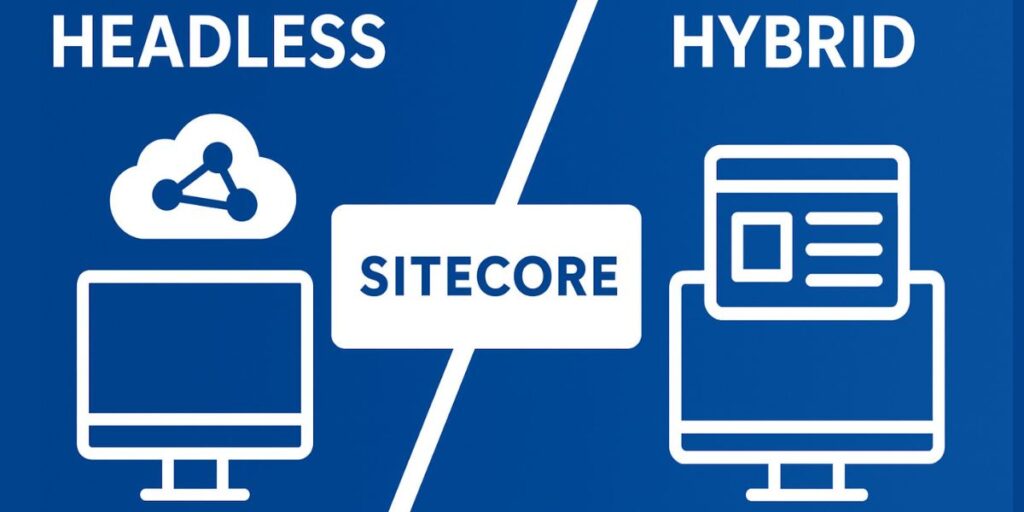Headless or Hybrid? Choosing the Right Sitecore Architecture for Your Business

Table of Contents
Introduction: Why Sitecore Architecture Matters in 2025
The way businesses build digital experiences is changing fast. In 2025, user expectations are higher than ever — visitors demand seamless, personalized, and lightning-fast interactions across all devices. For organizations using Sitecore, the key to delivering these experiences lies in choosing the right Sitecore architecture.
Sitecore has evolved from a traditional content management system (CMS) into a Composable Digital Experience Platform (DXP). With the introduction of Sitecore XM Cloud, Headless Services, and Composable tools, brands can now choose how tightly or loosely they want to couple their front-end and back-end.
That brings us to an important question: Should you go Headless or Hybrid with Sitecore?
In this article, we’ll explore the differences between the two, their pros and cons, and how Sitecore development services can guide you in selecting the best architecture for your business goals.
Understanding Sitecore Architecture Basics
Before diving into headless and hybrid models, it’s essential to understand the foundation of Sitecore architecture.
Traditionally, Sitecore followed a monolithic structure — where the content management (back-end) and the presentation (front-end) layers were tightly connected. Developers and marketers worked within the same environment, making it easier to manage content but harder to scale or integrate with other systems.
As the digital landscape expanded, businesses needed more flexibility. This led to the rise of decoupled and headless architectures, enabling content to be created once and delivered anywhere — web, mobile, smart devices, or apps.
Today, Sitecore offers both Headless and Hybrid approaches, giving organizations freedom to choose based on their needs.
What Is Headless Sitecore Architecture?
A Headless Sitecore architecture separates the content management system (the “body”) from the presentation layer (the “head”).
In simple terms, Sitecore handles content creation, storage, and delivery via APIs — while the front-end (built with frameworks like React, Angular, or Next.js) takes care of rendering the user experience.
Key Features of Headless Sitecore:
- API-first delivery: Content is distributed via Sitecore’s APIs to any channel or device.
- Front-end freedom: Developers can use modern JavaScript frameworks instead of being tied to Sitecore’s rendering engine.
- Faster performance: Decoupled architecture means faster page loads and better scalability.
- Omnichannel experience: Ideal for brands serving users across web, mobile, IoT, and digital displays.
Benefits of Headless Sitecore:
- Agility: Teams can work independently — marketers manage content, while developers handle front-end.
- Scalability: Easier to expand into new channels or regions.
- Future-proofing: Integrates smoothly with emerging technologies like AI and voice interfaces.
Best For:
Enterprises with strong in-house development teams, or brands that prioritize omnichannel content delivery and innovation.
What Is Hybrid Sitecore Architecture?
A Hybrid Sitecore architecture offers the best of both worlds — combining the flexibility of a headless setup with the built-in power of Sitecore’s traditional features like the Experience Editor, analytics, and personalization.
Instead of going fully decoupled, the hybrid approach allows teams to retain Sitecore’s presentation engine for certain parts of the site while using APIs for others. This makes it an excellent transition model for organizations that aren’t ready to go fully headless.
Key Features of Hybrid Sitecore:
- Partial decoupling: You can run traditional Sitecore pages and headless components side by side.
- Seamless personalization: Marketers can still use Sitecore’s native personalization and testing tools.
- Reduced complexity: Easier to manage for teams transitioning from monolithic setups.
Benefits of Hybrid Sitecore:
- Flexibility with control: Combine the stability of traditional Sitecore with modern API-driven development.
- Familiar workflow: Marketers can continue using tools like the Experience Editor.
- Cost-efficient transition: Avoids the steep learning curve and expense of a full headless rebuild.
Best For:
Businesses with existing Sitecore infrastructure who want modernization without losing familiar functionality.
Headless vs Hybrid: A Feature-by-Feature Comparison
| Feature | Headless Sitecore | Hybrid Sitecore |
| Flexibility | Extremely high — supports multiple front-end frameworks | Moderate — limited to Sitecore-compatible technologies |
| Personalization | API-driven, needs custom setup | Built-in and easy to manage |
| Development Speed | Fast for new builds | Fast for upgrades or partial rebuilds |
| Front-End Control | Full control for developers | Shared control between devs and marketers |
| Maintenance | Developer-heavy | Easier to maintain |
| Best For | Large-scale enterprises and omnichannel experiences | Organizations upgrading from legacy Sitecore setups |
How to Choose the Right Sitecore Architecture for Your Business
Choosing between headless and hybrid Sitecore architecture depends on several factors:
1. Your Current Setup
If your business already uses Sitecore and relies heavily on its marketing tools, the hybrid model offers a smoother path.
For new projects or replatforming efforts, headless may provide more flexibility and scalability.
2. Team Expertise
Headless architecture requires advanced development knowledge in JavaScript frameworks and API management.
If your team lacks these skills, a hybrid setup supported by professional Sitecore development services might be a better fit.
3. Content Delivery Goals
If your brand serves multiple digital touchpoints — like websites, mobile apps, kiosks, and IoT — headless Sitecore provides greater omnichannel capabilities.
4. Budget and Timeline
Hybrid implementations are generally quicker and more cost-effective for businesses already using Sitecore XP or XM.
Headless builds can be more resource-intensive initially but yield long-term ROI through scalability and flexibility.
5. Scalability and Future Vision
If your business aims for a fully composable, API-first ecosystem in the future, starting with headless Sitecore is the strategic move.
Real-World Examples
Example 1: Global Retail Brand – Headless Sitecore
A major retail brand adopted headless Sitecore XM Cloud to deliver consistent shopping experiences across their website, app, and in-store displays.
Result: Faster content delivery, improved performance, and unified omnichannel branding.
Example 2: B2B Enterprise – Hybrid Sitecore
A B2B manufacturing company with an existing Sitecore XP site switched to a hybrid model, combining legacy pages with new headless components for product catalogs.
Result: Smooth transition, preserved personalization data, and reduced downtime during migration.
Common Challenges & How to Overcome Them
For Headless Architecture:
- Complex integrations: APIs need proper orchestration to connect multiple services.
- Content governance: Without visual editing tools, marketers may find content management challenging.
- Solution: Engage experienced Sitecore implementation services to implement structured APIs, custom editing tools, and workflows.
For Hybrid Architecture:
- Limited flexibility: Still partially dependent on Sitecore’s rendering engine.
- Performance balancing: Managing both legacy and headless layers can get complex.
- Solution: Use Sitecore best practices like caching, containerization, and phased modernization for optimal results.
Future of Sitecore Architecture: The Composable Era
The future of Sitecore lies in composable architecture — where brands can choose the best components (content, commerce, personalization, analytics) and integrate them seamlessly.
With Sitecore XM Cloud, Sitecore Personalize, Sitecore CDP, and Sitecore Send, businesses can now build fully cloud-native, API-first ecosystems that scale globally.
Whether you start headless or hybrid today, the goal should be future-proofing your architecture — enabling flexibility, agility, and continuous innovation.
Conclusion
Both Headless and Hybrid Sitecore architectures offer unique advantages.
- If you’re seeking maximum flexibility, omnichannel capability, and developer freedom — go Headless.
- If you want stability, an easier transition, and access to native marketing tools — choose Hybrid.
Ultimately, the right choice depends on your business goals, technical maturity, and growth strategy.
To make the most of your investment, partner with trusted Sitecore development services. They can assess your current environment, recommend the ideal architecture, and ensure your platform is built for performance, personalization, and scalability.
Ready to modernize your digital experience?
Work with expert Sitecore architects to design a future-ready, high-performing solution tailored to your business needs.












